Home » Malaysia Regional Agricultural Trade Environment Assessment
![]() (843k) Malaysia RATE Summary
(843k) Malaysia RATE Summary
Malaysia presents a remarkable story of modern economic development. Over the past 40 years Malaysia has been transformed from an environment of food shortages, restricted human capacity, and ethnic divisions, to one with admirable level of food security, prosperity, and opportunity for its 29 million people. In the 1970s, Malaysia was internationally perceived as an impoverished and remote producer of a limited set of raw mining and agriculture materials. Today, it is an industrialized, upper-middle-income
economy that reasonably expects to join the World Bank-designated category of high-income countries by 2020.
Agricultural trade is enormously important to Malaysia’s economy. The country’s industrial crops of palm oil, rubber, cocoa
and tobacco contribute the vast majority of the 11 percent of GDP that the agriculture sector represents, and occupy about 77
percent of the country’s agricultural land.
The dedication of the country’s limited arable land to industrial farming, along with its significant industrialization over recent
generations, means that Malaysia is also a net importer of food. Still, production and processing of a wide variety of food
products on 16 percent of the land— including rice, fish, cash crops, and fruits and vegetables—remain a government
priority, both for purposes of food security and development of small and medium-sized enterprises.
Malaysia’s considerable advances in addressing food security and developing a modern economy offer important lessons and opportunities for other ASEAN Member States. In the broad area of agricultural trade, however, a number of challenges remain.
Issuing Country
Date
Wednesday, April 23, 2014 - 4:00am








Comment
Make a general inquiry or suggest an improvement.